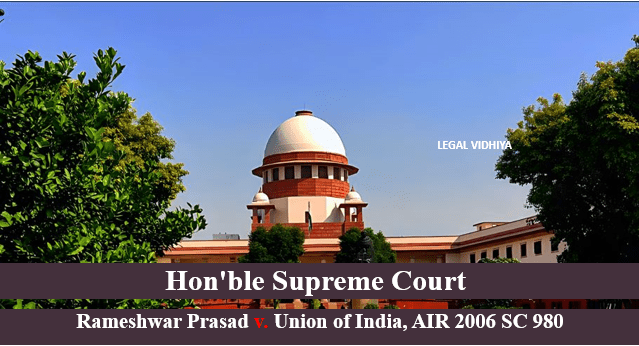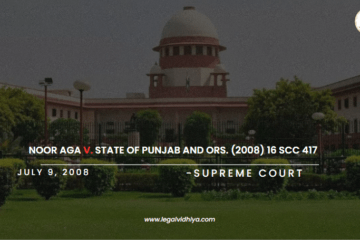
| Citation | AIR 2006 SC 980 |
| Date of Judgment | 24/01/2006 |
| Court | Supreme Court of India |
| Case Type | Writ Petition (civil) 257 of 2005 |
| Plaintiff | Rameshwar Prasad & Ors |
| Respondent | Union of India & Anr. |
| Bench | Hon’ble Judge Y.K. Sabharwal Cji, Hon’ble Judge K.G. Balakrishnan, Hon’ble Judge B.N. Agrawal, Hon’ble Judge Ashok Bhan, Arijit Pasayat |
| Referred | constitution of India, Representation of the People Act, 1951 |
Rameshwar Prasad vs. The Union of India, commonly known as the “Dissolution of the BIHAR COUNCIL”, is a unique case, primarily concerned with the question of electoral law that paved the way for a fair and transparent electoral process. more transparent than in India. . The main issue addressed in the ruling was “the legitimacy of post-election reorganization.” This case was a result of the Bihar Legislative Assembly elections of 2005 and in the Supreme Court of India the case was presided over by a constitutional jury of five judges headed by Honorary Chief Justice of India. At that time, Shri Y.K. Sabharwal paved the way for the development of the later electoral process in India.
FACTS:
The elections were held by the Election Commission of India in Bihar state in 2005 and the results were announced on 4 March 2005. The Bihar Council had a total of 243 seats and one party gained power and established government. required to pass the 122-seat gold bar. The distribution of seats won is shown below:
(1) National Democratic Alliance Party (NDA) 92
(2) Rashtriya Janta Dal Party (RJD) 75
(3) Lok Janshakti Party (LJP) 29
(4) National Assembly (I) 10
(5) Communist Party of India (Marxism-Leninism) [CPI(ML)] 07
(6) Samajwadi Festival 04
(7) National Congress Party (NCP) 03
(8) Bahujan Samaj Festival 02
(9) Independence 17
(10) Other 09
Thus, no party, alone or with its respective coalition, formed before an election, can overcome the simple majority barrier, resulting in the imposition of presidential rule in the country. states because they cannot form a government. Following the imposition of presidential rule, the two main coalition parties (NDA-BJP and RJD-JDU) engaged in illegal activities, including those carried out by MPs of the above parties. allegedly pledged money and political positions of the LJP deputy to persuade them. . These delegates are affected for reasons of religion, caste, creed, etc. The then governor of Bihar state bought the situation before the then honorary President of India Shri A.P.J. Abdul Kalam Azad, who was unnoticed in the Governor’s first letter, but held him in high esteem when the second letter was addressed to His Majesty. This led to an emergency cabinet meeting with the Honorary President, who made the decision to dissolve the Bihar Legislative Council on 23 May 2005, even before the Council held its first meeting. .
ISSUE:
The order of dissolution raised an upsurge in the political community which argued on the ground that, without even a single meeting and Assembly not being officially met once, how it could be regarded as functional and thereby if it wasn’t functional, then how it could be dissolved?
ARGUMENTS:
On October 7, 2005, a constitutional court headed by then Chief Justice of India YK Sabharwal issued a brief ruling.
The court declared the president’s declaration to dissolve the state parliament unconstitutional. However, the court decided not to reinstate Parliament due to the upcoming elections.
The Supreme Court ruled that the governor must stay away from controversies such as the removal of members of the Legislative Council. Thus, the Constitution contains provisions such as Section 192(2), which stipulates that the Governor must consult the Election Commission and act accordingly. Similarly, Article 103(2) of the Constitution has similar provisions for MPs.
The court held that although the governor was the main actor, the Union Cabinet should have considered the governor’s report before hastily accepting it as fact. The court found that the Governor misdirected the cabinet, causing the Cabinet to advise the President and issue a controversial statement.
The court found the governor’s actions to be dishonest and found that the underlying motive was to prevent a political party from attempting to form a government.
The Supreme Court has expressed concern over the actions of former Maharashtra Governor Bhagat Singh Koshyari, who exercised his power to demand a ground test that resulted in the resignation of former Chief Minister Uddhav Thackeray. The state is facing a crisis due to an uprising within the Shiv Sena party in June 2022, which resulted in the majority of MPs joining the faction led by incumbent Premier Eknath Shinde.
During the hearing, Judge DY Chandrachud, who heads a panel of five judges, questioned whether the governor had the power to intervene by ordering a background check in the event of dissent. internally within a party or not.
Judge PS Narasimha, a member of the panel, pointed out that the situation was different because unlike the current scenario in Maharashtra, no government was formed in the Rameshwar Prasad.
The Chief Justice of India (CJI) drew the distinction between the current case and Rameshwar Prasad’s decision after being reminded. He said the formation of a new government cannot be denied by the governor or rejected by the subjective assessment of the majority. According to CJI, the current government has been legally established.
DECISION:
In respect of the same, a Public Interest Litigation was filed before the Hon’ble Supreme Court of India to challenge the constitutional validity[BB1] of the President’s order of dissolution and the decision to the same was delivered on 24th January, 2006.
The decision in this case is made with 3:2 majority favouring the contention that the President’s order clearly meets the test of Unconstitutionality and was thus declared as UNCONSTITUTIONAL.
A 2nd majority supported the assertion that the President’s order clearly met the unconstitutional test requirement and was therefore declared ILLEGAL. “The minority opinion seems to be based primarily on the following grounds that affirm the constitutional validity of the presidential executive order. Firstly, the Bommai case is not applicable because there is no council in Bihar as in the case of Karnataka and Nagaland councils which have been dissolved. But it is argued that the different factual situation cannot deviate from, weaken or dilute the principles laid down in the Bombai case, nor can it replace its rationale. Second, he said, there is no evidence that the Governor actually prevented Janata Dal (U) from making the claims; the latter failed to take preliminary steps to assert his rights, which was prevented by the governor. With all due respect to the Court, it is argued that the minority has completely forgotten that the purpose and aim of the indecent hastily proposed dissolution of Parliament is to discourage even Nitish Kumar asked to form a government. Third, as Judge Pasayat pointed out, if the governor feels that what he is doing is morally wrong then it cannot be considered politically correct. That was his perception. It could be wrong. Its powers may not be specified in the Constitution. But in the end it is a perception. The majority ruling that changed the tide of elections in India argued that, according to the constitution, the most responsible official was the president, who let himself hastily sign the dissolution order. He could have asked the Council of Ministers, chaired by the Prime Minister, to wait; he could have taken the time, conducted the necessary consultations before signing the controversial decree dissolving the Bihar Council and should have made the decision only after careful deliberation. Furthermore, he could have sent the matter back to the Cabinet for reconsideration. All these rights and powers of the President are fully consistent with our constitutional framework. To the extent that the Court’s unconstitutional declaration in this case is the notice of the president, the office of the president cannot be excused from performing its constitutional responsibilities. “[i] But interestingly, the Court passed an interim order that almost created a constitutional irregularity by allowing a second election to take place. Indeed, this provisional order itself made the petition unsuccessful, because when the judgment was made in this case, the second government was in power and this is why the order of The president was declared unconstitutional, but the restoration of the status quo was not ordered. . This creates the anomaly between whether this case is really a victory of constitutionality over political evil or whether the latter is showing its strength?
CONCLUSION:
Overall, the Rameshwar Prasad case against the Union of India constitutes an important analysis of the governor’s role in the imposition of presidential power. It can be said that if there is a situation where the state management agency cannot operate in accordance with the provisions of this Constitution. Then the governor found himself crossing a thin line between the role of constitutional custodian and the role of autocratic political ombudsman.
REFERENCES:
https://indiankanoon.org/doc/79280249/
https://www.lawyersclubindia.com/judiciary/Rameshwar-Prasad-Ors-v-s-Union-of-India-ANR–4131.asp
https://byjus.com/free-ias-prep/rameshwar-prasad-vs-union-of-india-case-upsc-notes/
This Article is written by Bhavya Arora of Lloyd Law College, an Intern at Legal Vidhiya.




0 Comments